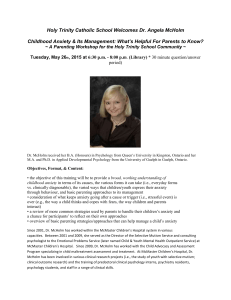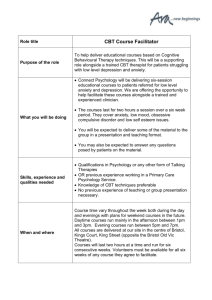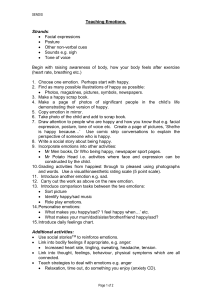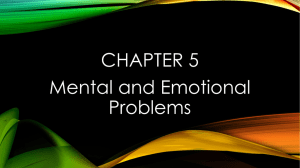European_Psychologist
advertisement
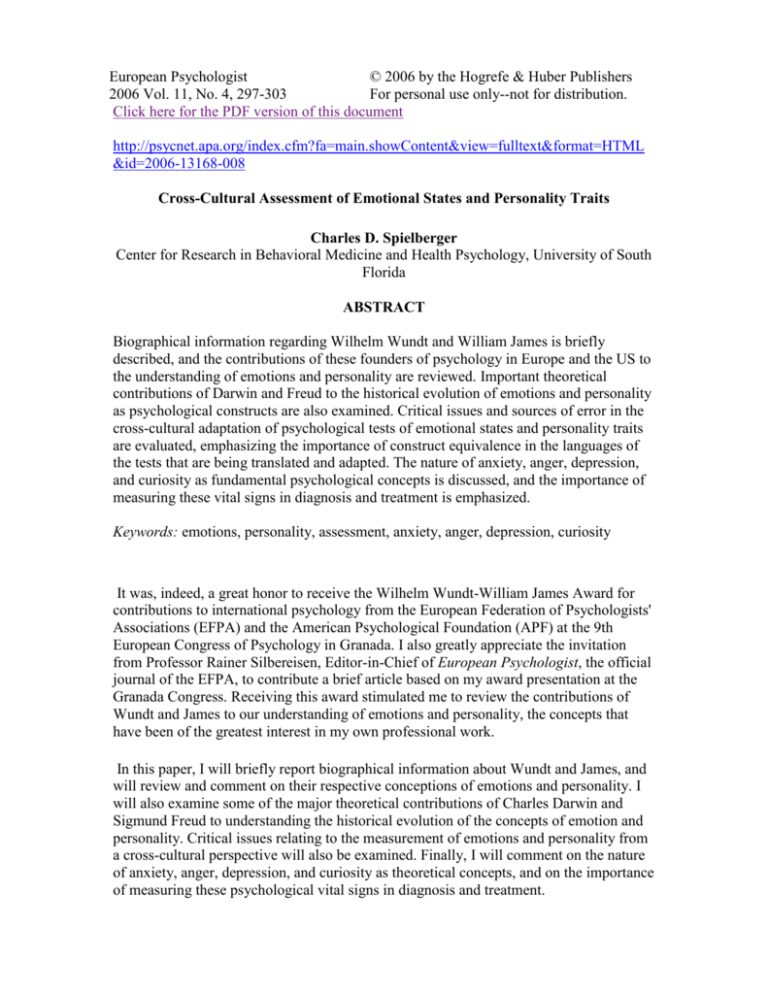
European Psychologist © 2006 by the Hogrefe & Huber Publishers 2006 Vol. 11, No. 4, 297-303 For personal use only--not for distribution. Click here for the PDF version of this document http://psycnet.apa.org/index.cfm?fa=main.showContent&view=fulltext&format=HTML &id=2006-13168-008 Cross-Cultural Assessment of Emotional States and Personality Traits Charles D. Spielberger Center for Research in Behavioral Medicine and Health Psychology, University of South Florida ABSTRACT Biographical information regarding Wilhelm Wundt and William James is briefly described, and the contributions of these founders of psychology in Europe and the US to the understanding of emotions and personality are reviewed. Important theoretical contributions of Darwin and Freud to the historical evolution of emotions and personality as psychological constructs are also examined. Critical issues and sources of error in the cross-cultural adaptation of psychological tests of emotional states and personality traits are evaluated, emphasizing the importance of construct equivalence in the languages of the tests that are being translated and adapted. The nature of anxiety, anger, depression, and curiosity as fundamental psychological concepts is discussed, and the importance of measuring these vital signs in diagnosis and treatment is emphasized. Keywords: emotions, personality, assessment, anxiety, anger, depression, curiosity It was, indeed, a great honor to receive the Wilhelm Wundt-William James Award for contributions to international psychology from the European Federation of Psychologists' Associations (EFPA) and the American Psychological Foundation (APF) at the 9th European Congress of Psychology in Granada. I also greatly appreciate the invitation from Professor Rainer Silbereisen, Editor-in-Chief of European Psychologist, the official journal of the EFPA, to contribute a brief article based on my award presentation at the Granada Congress. Receiving this award stimulated me to review the contributions of Wundt and James to our understanding of emotions and personality, the concepts that have been of the greatest interest in my own professional work. In this paper, I will briefly report biographical information about Wundt and James, and will review and comment on their respective conceptions of emotions and personality. I will also examine some of the major theoretical contributions of Charles Darwin and Sigmund Freud to understanding the historical evolution of the concepts of emotion and personality. Critical issues relating to the measurement of emotions and personality from a cross-cultural perspective will also be examined. Finally, I will comment on the nature of anxiety, anger, depression, and curiosity as theoretical concepts, and on the importance of measuring these psychological vital signs in diagnosis and treatment. Contributions of Wundt and James to Understanding Emotions and Personality Wilhelm Wundt and William James are generally considered to be the founders of psychology in Europe and the US. Born in 1832 in the village of Neckarau in Germany, Wundt studied medicine at Tübingen, Heidelberg, and Berlin, but was more interested in the scientific foundation on which medicine was based than in professional practice. He was appointed assistant professor at the University of Heidelberg in 1864, where he established the first course in physiological psychology, which focused on sensory physiology and behavioral reactions. His lecture notes were published in 1873 as his major work, Grundzüge der Physiologischen Psychologie (Principles of Physiological Psychology), which was subsequently revised (Wundt, 1897). The establishment of Wundt's lab at the University of Leipzig in 1879 is generally celebrated as the founding of experimental psychology as an academic discipline. Wundt accepted the Spinozean idea of psychophysical parallelism, theorizing that every physical event has a mental counterpart and vice versa. He developed experimental introspection, a method in which researchers carefully observed specific internal experiences in terms of their quality, intensity, and duration. Wundt considered humans to be “emotional creatures,” and assumed that all mental activities involved emotion, which preceded cognition. He distinguished between feelings as short-lived experiences, and emotions as more complex experiences that generally involved several related feelings. Consequently, he concluded that it was not possible to identify specific emotions because they tended to blend into each other. Wundt disagreed with the JamesLange Theory, which assumed that a person first responded to a situation and then experienced an emotion. According to Wundt, introspection demonstrated that emotions and physiological arousal came first, followed by cognition and behavioral consequences. In early studies of human emotions, introspective reports were used in efforts to discover and measure the qualitative feeling states (“mental elements”) that were associated with different emotions (Titchner, 1879; Wundt, 1897). However, the findings that resulted from this phenomenological approach were inconsistent and generally unrelated to other behaviors (Plutchik, 1962; Young, 1943). Consequently, self-reports came to be viewed with extreme suspicion because they were unverifiable and easily falsified (Duffy, 1941). The validity of verbal self-reports was further challenged by psychoanalytic formulations that emphasized the distortions produced by the effects of unconscious mental processes on mood and thought. William James was born in New York City in 1842. He entered Harvard in 1861 to study chemistry, but soon changed to medicine. He went to Germany in 1867 to study physiology under Helmholtz, returning to Harvard in 1869 to complete his M.D. degree, but was not interested in a career in medicine. Like Wundt, he preferred to study the science that was related to medicine. In 1872, James was appointed instructor of physiology at Harvard, and taught what is considered the first U.S. course on psychology in 1875. His title at Harvard was changed in 1880 to assistant professor of philosophy; he became a full professor in 1885. In 1889 James' title was changed to professor of psychology; his classic book (James, 1890), The Principles of Psychology (2 volumes), was published the following year. A shorter version, published in 1892 with the subtitle The Briefer Course, was referred to by students as “The Jimmy” for the next 50 years. James' books were extremely popular among psychology students and laypersons alike. He also raised money for a new lab at Harvard, and arranged to hire one of Wundt's students, Hugo Münsterberg, as its director. In his books, James devoted an entire chapter to “The Emotions,” which he considered to be similar to instincts. In describing emotions, James quotes extensively from Darwin and gives considerable attention to fear, which he defined as “a genuine instinct.” Symptoms of fear included perspiration (cold sweat), hurried breathing, and increased heart rate and blood pressure. The importance of anger was also recognized by James, who observed that when an individual experienced intense anger or rage, “he strikes, kicks, and throttles whomever he can lay his hands on.” Similar to fear and anger, James also considered curiosity to be an instinct, which contributed to resolving puzzles and stimulating reactions to novel situations. Portraits of Wundt and James are shown in Figure 1. Historical Evolution of Emotions and Personality as Theoretical Concepts Fear and rage were considered by Darwin (1965/1872) to be universal characteristics of both humans and animals that were clearly reflected in facial expressions. He theorized that these emotions evolved over time through a process of natural selection because they facilitated successful adaptation and survival (Plutchik, 2001). According to Darwin (1965/1872, p. 176), “If we expect to suffer, we are anxious; if we have no hope of relief, we despair.” Thus, Darwin explicitly related anxiety to fear and depression. He regarded fear as “.. . the most depressing of all the emotions; and it soon induces utter, helpless prostration” (Darwin, 1965/1872, p. 81). Rage was also considered by Darwin (1965/1872, p. 74) to be a powerful emotion that motivated “.. . animals of all kinds, and their progenitors before them, when attacked or threatened by an enemy” to fight and defend themselves. He observed that rage was reflected in facial expressions, clenched teeth, dilated nostrils, accelerated heart-rate, and muscular tension, and often resulted in violent behavior. For Darwin (1965/1872, p. 244), anger was a state of mind that differed “.. . from rage only in degree, and there is no marked distinction in their characteristic signs.” Thus, Darwin implicitly defined anger as an emotional state that varies in intensity, from mild irritation or annoyance to intense fury and rage. Freud (1924) emphasized the importance of anxiety, which he defined as “something felt,” a specific unpleasant emotional state or condition that included apprehension, tension, worry, and physiological arousal. He equated fear with objective anxiety, which he considered to be an emotional reaction proportional in its intensity to a real danger in the external world (Freud, 1936). Objective anxiety was generally beneficial because it served to warn the individual of a danger to which some form of adjustment was necessary. Consistent with Darwin's evolutionary perspective, Freud's “danger signal” theory emphasized the adaptive utility of anxiety in motivating behavior that helped a person to cope more effectively with potentially harmful situations. Aggression was considered by Freud to be an instinctual drive that motivated anger and aggressive behavior. Aggressive impulses, accompanied by anger and rage, were conceptualized by Freud (1959/1933) as resulting from a biologically determined “death instinct” (thanatos) that motivated people to destroy themselves. However, because thanatos was inhibited by a more powerful life instinct (libido), the aggressive energy of this self-destructive drive was directed toward other persons or objects in the environment. Aggression that could not be expressed against external objects was turned back onto the self, resulting in depression and other psychosomatic manifestations (Alexander & French, 1948; Freud, 1936). The origin of the concept of depression can be traced back to the 5th century B.C. writings of Hippocrates, the father of modern medicine (Jackson, 1986, 1995). The Greek term, melancholia, which had the connotation of both anxiety and depression, was used by Hippocrates to describe a “black mood” that involved prolonged fear and sadness (Jackson, 1995). Depression (melancholia), fear (anxiety), and anger (hostility, rage) were considered by Darwin and Freud to be fundamental emotional states that had powerful effects on thoughts and behavior. Both Darwin and Freud also recognized that depression resulted from the interaction of anxiety and anger. Like anxiety and anger, symptoms of depression vary in severity (intensity) and frequency, from feeling sad or gloomy for a relatively short period of time to the frequent experience of deep despair, extreme guilt, hopelessness, and thoughts of death that could result in suicide. Persistent depression may also contribute to physical and behavioral symptoms such as fatigue, insomnia, frequent crying, chronic aches and pain, and excessive gain or loss in weight (Rosenfeld, 1999). In theory and research on psychopathology, anxiety and anger have been recognized as major contributors to depression and other emotional disorders for the last 100 years (Freud, 1924, 1936; May, 1977/1950). The measurement of anxiety in psychological testing and treatment planning has also received significant attention for more than half a century (Spielberger, 1983; Taylor, 1953). While the assessment of anger has been relatively neglected, evidence from research on Type A behavior and heart disease (Spielberger, 1976; Spielberger & London, 1982), demonstrating that anger was the lethal component of the Type A syndrome, has stimulated the development of measures of the experience, expression, and control of anger (Spielberger, 1980, 1988, 1999; Spielberger et al., 1985). Freud (1936, 1959) viewed the insecurity caused by anxiety as the major instigator of exploratory behavior, thus implicitly linking curiosity to anxiety. Although Freud did not directly address the nature of curiosity, he considered exploratory behavior to be determined by instinctive biological urges and ego mechanisms that served to reduce threat and insecurity (Aronoff, 1962). Strongly influenced by Darwin's (1965/1872) views on evolution, William James (1890) also proposed an instinct theory of curiosity. James considered attraction to novel stimuli to be adaptive because it facilitated survival, but fear (anxiety) aroused by novel situations was also adaptive because the novel stimulus might prove to be dangerous. Like Freud, James recognized a potentially antagonistic relationship between curiosity and fear, which often resulted in the simultaneous arousal of these emotions. Broadly defined, curiosity involves the motivation to acquire new knowledge and experience, which motivates exploratory behavior (James 1890; Loewenstein, 1994; McDougall, 1921). Although scientific interest in curiosity has been reflected in the history of the discipline of psychology for more than 100 years, research on curiosity has received only passing attention (Spielberger & Starr, 1994). Daniel Berlyne (1949, 1950), clearly the most influential contributor to experimental research on curiosity, identified two types of curiosity; perceptual curiosity defined as “the curiosity which leads to increased perception of stimuli” (Berlyne, 1954, p. 180), and epistemic curiosity as “the drive to know” (p. 187). Berlyne (1960) also differentiated between two types of exploratory behavior, which he labeled diversive and specific. Feelings of boredom motivate diversive exploration; specific exploration is motivated by the desire to acquire information about novel stimuli. Cross-Cultural Assessment of Emotional States and Personality Traits Hambleton (1994; Hambleton & Patsula, 1999) has reviewed a wide range of general issues and sources of error that are encountered in the cross-cultural adaptation of psychological tests. These included cultural and language differences, technical and methodological problems, and factors that influence the interpretation of test results. Cultural differences have a greater influence on the assessment of emotions than they do on abilities and achievement because emotions are more subjective and less clearly defined (Anastasi, 1988). While construct equivalence in different cultures is an essential requirement in the adaptation of tests, it is especially important for measures of emotion and personality because there is, as yet, relatively little agreement regarding the criteria for defining these dimensions. Special attention must also be given to the state-trait distinction (Cattell & Scheier, 1960; Spielberger, 1966), and the concept of item-intensity specificity (Anastasi, 1988; Spielberger, Gorsuch, & Lushene, 1970). In the cross-cultural adaptation of psychological tests, the key words for an item in the original language may have several different translations that are equally acceptable in the target language. Different key words for two or more items in the source language may also be represented by a single word in the target language. Where the literal translation of a test item is not possible, it is essential to retain the meaning of the key words by selecting synonyms in the target language. For test items that contain idiomatic expressions, special care must be given to translating the feeling connotation of an idiom, rather than the literal meaning of individual words (Guthrie & Lonner, 1986). Identifying comparable idiomatic expressions in the target language is generally preferable to the literal translation of the original idiom. Clearly, the cross-cultural equivalence of the theoretical concepts that are being measured is essential. The words used in different languages to describe emotional states and personality traits generally have a wide range of connotations (Rogler, 1999; Wierzbiecka, 1994). Even within a particular language, the same word may have a variety of meanings in different subcultures (Anastasi, 1988). As noted by Wierzbiecka (1994, p. 135), “The set of emotion terms available in any given language is unique and reflects a culture's unique perspective on peoples' ways of feeling.” Examples of subcultural differences in the meaning of Spanish words are noted in Table 1, which clearly indicate that culture can have a profound impact on key words even in the same language (Cabrera, 1998). The process of “back-translation” is traditionally used to facilitate adapting psychological tests from one language to another (Brislin, 1970, 1986). In the backtranslation of test items, the literal translation of words is emphasized. However, backtranslation of an original item for measuring emotions and personality is often less adequate than constructing a new item based on the equivalent cross-cultural conceptual definition of the emotional state or personality dimension that is being measured (Spielberger & Diaz-Guerrero, 1983). This is especially true in adapting items that contain idiomatic expressions. Given the difficulties encountered in translating key words and idiomatic expressions in the cross-cultural adaptation of measures of emotions and personality, a substantially larger pool of items should be constructed than will eventually be needed. Statistical procedures can then be used to determine which items have the best psychometric properties for measuring the specified construct. In developing adaptations of the STAI State (S-Anxiety) and Trait (T-Anxiety) Scales (Spielberger, 1983; Spielberger et al., 1970), the unique psycholinguistic properties of different languages have been utilized. In Spanish, for example, there are two forms of the verb “to be,” ser and estar. Ser denotes a relatively stable or permanent characteristic of a person or situation, whereas estar has the connotation of a transitory state or temporary condition (Spielberger, Gonzalez-Reigosa, Martinez-Urrutia, Natalicio, & Natalicio, 1971). The Portuguese distinction between the two verbs is very similar to Spanish, but with a greater emphasis on temporary and relatively persistent psychological concepts (Wikipedia, 2005). Verbs in the Hindi language also correspond to describing transitory states and relatively stable personality traits (Spielberger, Sharma, & Singh, 1973). The fact that the state-trait distinction is intrinsic to the Spanish/Portuguese and Hindi languages, as indicated by the psycholinguistic structure of these very different language systems, strongly supports the fundamental need to distinguish between the intensity of emotional states and individual differences in personality traits. The state-trait distinction is also clearly reflected in particular words that have the connotation of anxiety and anger as transitory states that vary in intensity, such as feeling upset or furious, and by items such as “I have disturbing thoughts,” which imply a more persistent and frequently experienced trait (Spielberger, 1983). Given the strong evidence for the state-trait distinction that is inherent in the linguistic structure of Spanish, Portuguese, Hindi, and other languages, it is important to assess the full range of the intensity of emotional states and individual differences in how often personality traits are experienced (Spielberger & Sharma, 1976). Individual differences in anxiety, anger, and depression as personality traits can be evaluated in terms of the frequency that these emotions are experienced. Similar to the variations in magnitude that are evaluated by physiological measures such as heart rate and blood pressure, self-report scales for assessing emotional states must be sensitive to evaluating variations in intensity. In adapting measures of emotions and personality for cross-cultural assessment, identifying words in different languages that denote varying levels of item-intensity specificity is an essential requirement. Clearly, feeling annoyed or furious reflects different levels of the intensity of anger as an emotional state. Items that describe positive feelings, such as calm and secure, and that correlate substantially and inversely with items indicating the presence of anxiety, such as feeling tense and nervous, should be used for assessing low levels of the intensity of emotional states. In measuring anxiety and depression, it is also important to include items that describe positive feelings, indicating the absence of these emotions, in order to assess the full range of the emotional intensity in normal populations. Measuring Psychological Vital Signs in Diagnosis and Treatment Emotions motivate behavior and have a significant impact on health and psychological well-being. It is, therefore, essential to evaluate and monitor emotional states in diagnosis and treatment, just as physicians in medical examinations routinely measure pulse rate, blood pressure, and temperature, the vital signs that provide essential information about physical health. When a physician detects an abnormal pulse during a physical examination, this finding signals a potentially significant problem in the functioning of the cardiovascular system. A high fever may be symptomatic of a serious medical condition, indicating that the immune system is not protecting the person from harmful viruses. Intense anxiety and anger are analogous to elevations in pulse rate and blood pressure, whereas depression may be considered as roughly analogous to having a fever. While fevers can usually be reduced by aspirin or acetaminophen in patients with colds or the flu, the emotional conflicts that contribute to clinical depression are not likely to be substantially relieved by either drugs or simple behavioral interventions. Because the threshold for seeking psychological treatment tends to be higher than for using medication to alleviate fever or pain, the problems that cause the emotional fever of depression are more likely to persist to a point of crisis before help is sought. Anxiety, anger, and depression are the psychological vital signs that are most critical to an individual's well-being. Variations in the intensity and duration of these emotional states provide essential information about a person's mental health, and can help to identify recent events, as well as long-standing conflicts, that have particular meaning and impact on an individual's life. Assessing emotional vital signs and providing timely and meaningful feedback during treatment will enhance a patient's awareness and understanding of her/his feelings. Helping patients to cope with their feelings can also help them to deal more effectively with the underlying problems and contribute to a more favorable treatment outcome. Symptoms of anxiety are typically found in almost all emotional disorders. Freud (1936, p. 85) regarded anxiety as the “fundamental phenomenon and the central problem of neurosis.” According to de la Torre (1979), helping people to cope with their feelings of anxiety should be a major priority in all forms of psychotherapy, and especially in crisis intervention and dynamic treatments that focus on the specific problems of a patient or client. Recent research findings, as well as observations of daily life, suggest that problems with anger are especially ubiquitous. In a series of studies, Deffenbacher (1992) and his associates (Deffenbacher, Demm, & Brandon, 1986; Deffenbacher, Story, Stark, Hogg, & Brandon, 1987; Hogg & Deffenbacher, 1986) found that persons high in anger as a personality trait frequently experienced angry feelings across a wide range of situations. Consequently, careful assessment of the experience, expression, and control of anger is essential in diagnosis and treatment planning (Sharkin, 1988; Spielberger, 1988, 1989). Depression has been described as “the common cold of mental health problems that strikes the rich and poor as well as the young and the old” (Rosenfeld, 1999, p. 10). Depression also contributes to behavioral and physical symptoms, such as fatigue, insomnia, impotence, frequent crying, chronic aches and pain, and excessive gain or loss in weight (Rosenfeld, 1999). The World Health Organization estimates that 340 million people currently suffer from clinical depression. According to the WHO (2001), depression will become “the leading cause of disability and the 2nd leading contributor to the global burden of disease by the year 2020.” Clearly, depression is a complex, multifaceted syndrome that is comprised of a number of underlying dimensions. Like anxiety and anger, the assessment of the intensity of depression as an emotional state and individual differences in how often depression is experienced as a personality trait is essential in diagnosis and treatment. What does curiosity add to the assessment of emotional vital signs? As a motivator of creativity and exploratory behavior, curiosity may be considered as a positive vital sign that contributes to personal adjustment and the successful adaptation to environmental stimuli. Research has shown that anxiety, anger, and depression are inversely related to curiosity, indicating that negative emotions interfere with and inhibit curiosity's positive and adaptive effects. Thus, curiosity may be considered as a positive vital sign and a strong indicator of an individual's psychological well-being. In summary, substantial progress has been made in clarifying the nature and measurement of emotional states and personality traits, and their use in cross-cultural research. Recognition of the major influence of anxiety, anger, depression, and curiosity in everyday life, along with the substantial findings in empirical research, clearly indicate that these emotional states and personality traits will have a profound impact on behavior, and will continue to be topics of substantial interest in psychological, social, and medical research. References Alexander, F.G., & French, T.M. (Eds.). (1948). Studies in psychosomatic medicine: An approach to the cause and treatment of vegetative disturbances New York: Ronald Anastasi, A. (1988). Psychological testing (6th ed.). New York: Macmillan Aronoff, J. (1962). Freud's conception of the origin of curiosity. The Journal of Psychology, 39-45. Berlyne, D.E. (1949). Interest as a psychological concept. British Journal of Psychology, 184-185. Berlyne, D.E. (1950). Novelty and curiosity as determinants of exploratory behavior. British Journal of Psychology, 50-68. Berlyne, D.E. (1954). A theory of human curiosity. British Journal of Psychology, 180191. Berlyne, D.E. (1960). Conflict, arousal, and curiosity. New York: McGraw-Hill Brislin, R.W. (1970). An introduction to motivation. Princeton, NJ: Van NostrandReinhold Brislin, R.W. (1986). Back-translation for cross-cultural research. Journal of CrossCultural Psychology, 185-216. Cabrera, C. (1998, August 16). Tricky translations: When speaking Spanish, what's acceptable in some countries could get you in trouble in others. The Tampa Tribune, 1-12. Cattell, R.B., & Scheier, I.H. (1960). Stimuli related to stress, neuroticism, excitation, and anxiety response patterns. Journal of Abnormal and Social Psychology, 195-204. Darwin, C. (1965/1872). The expression of emotions in man and animals. Chicago: University of Chicago Press Deffenbacher, J.L. (1992). Trait anger: Theory, findings, and implications. In C.D. Spielberger & J.N. Butcher (Eds.), Advances in personality assessment (Vol. 9, pp. 177-201.) Hillsdale, NJ: Erlbaum Deffenbacher, J.L., Demm, P.M., & Brandon, A.D. (1986). High general anger: Correlates and treatment. Behavior Research and Therapy, 480-489. Deffenbacher, J.L., Story, D.A., Stark, R.S., Hogg, J.A., & Brandon, A.D. (1987). Cognitive-relaxation and social skills interventions in the treatment of general anger. Journal of Counseling Psychology, 171-176. de la Torre, J. (1979). Anxiety states and short-term psychotherapy. In W.E. Fann, I. Karacan, A.D. Polorny, & R.L. Williams (Eds.), Phenomenology and treatment of anxiety (pp. 377- 388). Jamaica, NY: Spectrum Publications, Inc Duffy, F. (1941). An explanation of “emotional” phenomena without the use of the concept “emotion.” Journal of General Psychology, 283-293. Freud, S. (1924). Collected papers (Vol. 1). London: Hogarth Press Freud, S. (1936). The problem of anxiety. New York: Norton Freud, S. (1959/1933). Why war? In J. Strachey (Ed.), Collected papers (Vol. 5). London: Hogarth Guthrie, G.M., & Lonner, W.J. (1986). Assessment of personality and psychopathology. In W.J. Lonner & J.W. Berry (Eds.), Field methods in cross-cultural research (Vol. 8, pp. 231-264). Beverly Hills, CA: Sage Hambleton, R.K. (1994). Guidelines for adapting educational and psychological tests: A progress report. European Journal of Psychological Assessment, 229-244. Hambleton, R.K., & Patsula, L. (1999). Increasing the validity of adapted tests: Myths to be avoided and guidelines for improving test adaptation practices. Journal of Applied Testing Technology, 1-16. Hogg, J.A., & Deffenbacher, J.L. (1986). Irrational beliefs, depression, and anger in college students. Journal of College Student Personnel, 349-353. Jackson, S.W. (1986). Melancholia and depression: From Hippocratic times to modern times. New Haven: Yale University Press Jackson, S.W. (1995). A history of melancholia and depression. In G.H. Pollock & H.M. Visotsky (Eds.) Depression and Stress, 1(1), 3-42 James, W. (1890). The principles of psychology. New York: Holt Loewenstein, G. (1994). The psychology of curiosity: A review and reinterpretation. Psychological Bulletin, 75-98. May, R. (1977/1950). The meaning of anxiety. New York: Norton McDougall, W. (1921). An introduction to social psychology. Boston: Luc Plutchik, R. (1962). The emotions. New York: Random House Plutchik, R. (2001). The nature of emotions. American Scientist, July-August, 1989. Rogler, L.H. (1999). Methodological sources of cultural insensitivity in mental health research. American Psychologist, 424-433. Rosenfeld, I. (1999, September 19). When the sadness won't go away. Parade Magazine, -. Sharkin, B.S. (1988). Treatment of client anger in counseling. Journal of Counseling and Development, 361-365. Spielberger, C.D. (1966). Theory and research on anxiety. In C.D. Spielberger (Ed.), Anxiety and behavior (pp. 3-20). New York: Academic Press Spielberger, C.D. (1976). Stress, anxiety, and cardiovascular disease. Journal of the South Carolina Medical Association, 15-22. Spielberger, C.D. (1980). Preliminary manual for the State-Trait Anger Scale (STAS). Tampa, FL: University of South Florida, Human Resources Institute Spielberger, C.D. (1983). Manual for the State-Trait Anxiety Inventory: STAI (Form Y). Palo Alto, CA: Consulting Psychologists Press Spielberger, C.D. (1988). Manual for the State-Trait Anger Expression Inventory (STAXI). Odessa, FL: Psychological Assessment Resources, Inc Spielberger, C.D. (1999). Professional manual for the State-Trait Anger Expression Inventory-2 (STAXI-2). Odessa, FL: Psychological Assessment Resources, Inc Spielberger, C.D., & Diaz-Guerrero, R. (1983). Cross-cultural anxiety: An overview. In C.D. Spielberger & R. Diaz-Guerrero (Eds.), Cross-cultural anxiety (Vol. 2, pp. 3-11). New York: Hemisphere/McGraw-Hill International Spielberger, C.D., Gonzalez-Reigosa, F., Martinez-Urrutia, A., Natalicio, L., & Natalicio, D. (1971). Development of the Spanish edition of the State-Trait Anxiety Inventory. Interamerican Journal of Psychology, 3-4. Spielberger, C.D., Gorsuch, R.L., & Lushene, R.D. (1970). STAI: Manual for the State- Trait Anxiety Inventory. Palo Alto, CA: Consulting Psychologists Press Spielberger, C.D., Johnson, E.H., Russell, S.F., Crane, R.J., Jacobs, G.A., & Worden, T.J. (1985). The experience and expression of anger: Construction and validation of an anger expression scale. In M.A. Chesney & R.H. Rosenman (Eds.), Anger and hostility in cardiovascular and behavioral disorders (pp. 5-30). New York: Hemisphere/McGraw-Hill Spielberger, C.D., & London, P. (1982). Rage boomerangs: Lethal Type-A anger. American Health, 52-56. Spielberger, C.D., & Sharma, S. (1976). Cross-cultural measurement of anxiety. In C.D. Spielberger & R. Diaz-Guerrero (Eds.), Cross-cultural research on anxiety (pp. 1325). Washington, DC: Hemisphere Spielberger, C.D., Sharma, S., & Singh, M. (1973). Development of the Hindi edition of the State-Trait Anxiety Inventory. Indian Journal of Psychology, 11-20. Spielberger, C.D., & Starr, L.M. (1994). Curiosity and exploratory behavior. In H.F. O'Neil, Jr. & M. Drillings (Eds.), Motivation: Theory and research. Hillsdale, NJ: Erlbaum Taylor, J.A. (1953). A personality scale of manifest anxiety. Journal of Abnormal Social Psychology, 285-290. Titchener, E.B. (1879). An outline of psychology. New York: MacMillan WHO. (2001). World health report on mental health: New understanding, new hope. Geneva: Author Wierzbiecka, A. (1994). Emotion, language, and cultural scripts. In S.E. Kitayama & H.R.M. Markus (Eds.), Emotion and culture: Empirical studies of mutual influence (pp. 133-195). Washington, DC: American Psychological Association Wikipedia: The Free Encyclopedia. (2005). Romance Copula. Retrieved on February 14, 2005 from http://en.wikipedia.org/wiki/ser and estar in Castilian Wundt, W. (1897). Outlines of psychology (C.H. Judd, Trans.). Leipzig: Wilhelm Engelmann. (Reprinted Bristol: Thoemmes, 1999; first published in German as W. Wundt (1896). Grundriss der Psychologie. Leipzig: Wilhelm Engelmann.) Young, P.T. (1943). Emotion in men and animal. New York: Wiley Charles D. Spielberger, PhD, is Distinguished Research Professor Emeritus of Psychology and Director of the Center for Research in Behavioral Medicine and Health Psychology at the University of South Florida, Tampa, Florida, USA. His measures of state and trait anxiety and the experience, expression, and control of anger are currently widely used in research, with translations and adaptations in many European languages. This paper is an expanded version of the award address given by the author at the 9th European Congress of Psychology in Granada, Spain, in July 2005, following his receipt of the Wilhelm Wundt-William James Prize. For further details please see www.efpa.be Correspondence concerning this article should be addressed to Charles D. Spielberger, Center for Research in Behavioral Medicine and Health, Psychology, PCD 4118G, University of South Florida 4202 East Fowler Avenue, TampaFL 33620-7200, USA E-mail: spielber@cas.usf.edu Table 1. Examples of differences in the meaning of Spanish words in different cultures Figure 1. Portraits of Wilhelm Wundt and Williams James, who are generally regarded as the founders of psychology in Europe and America



